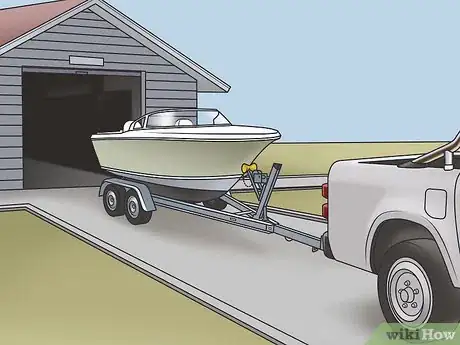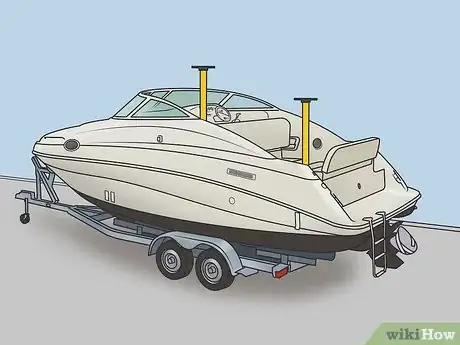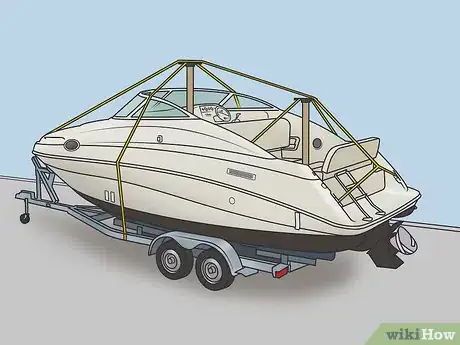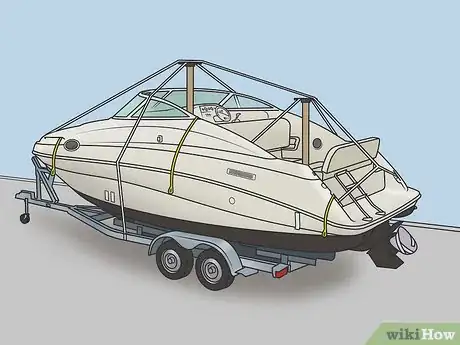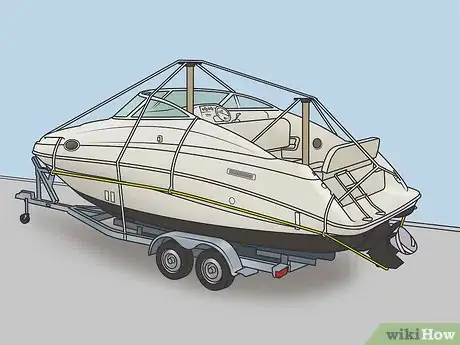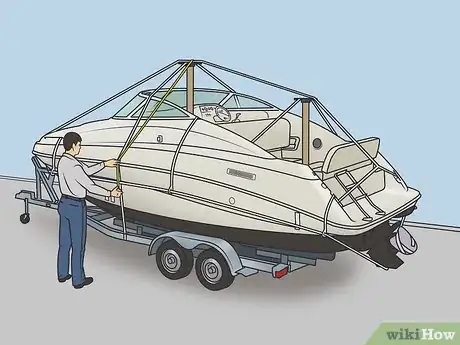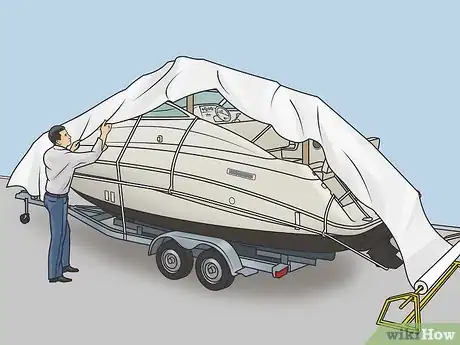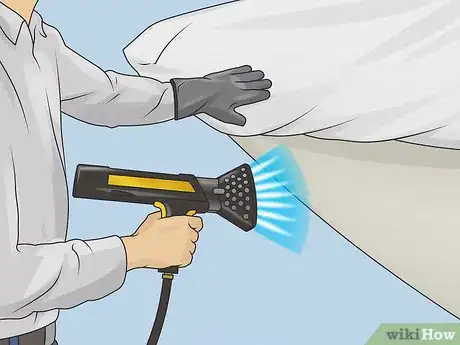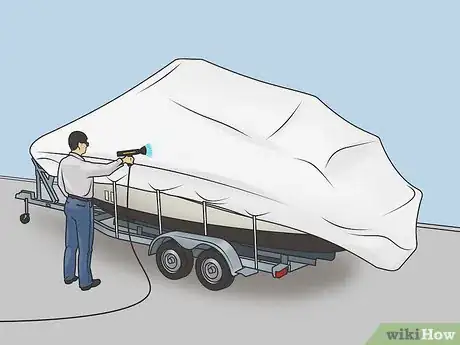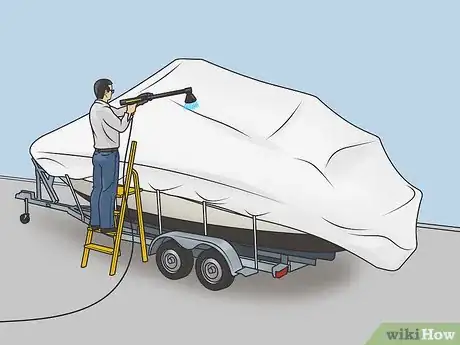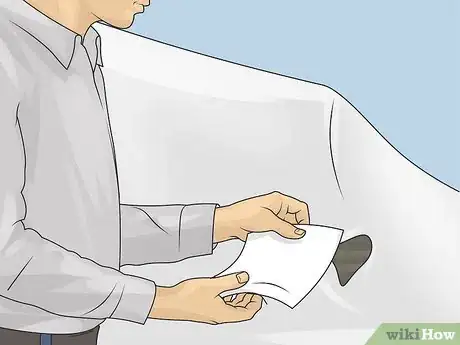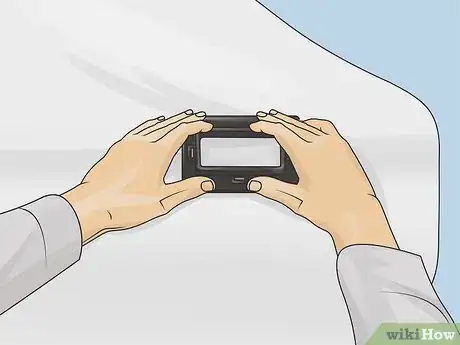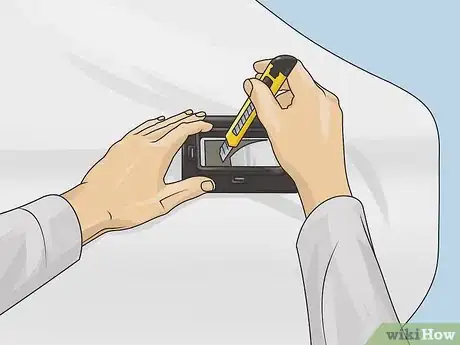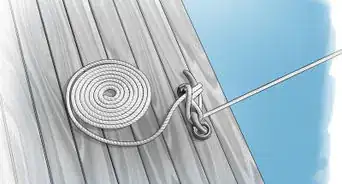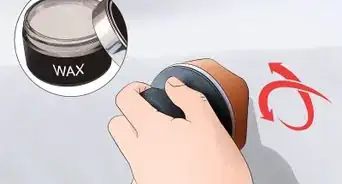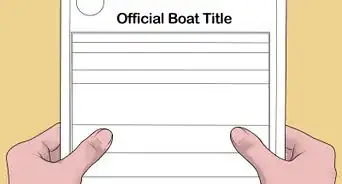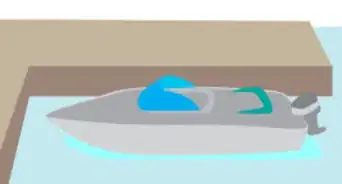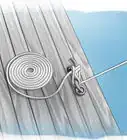This article was co-authored by wikiHow Staff. Our trained team of editors and researchers validate articles for accuracy and comprehensiveness. wikiHow's Content Management Team carefully monitors the work from our editorial staff to ensure that each article is backed by trusted research and meets our high quality standards.
There are 16 references cited in this article, which can be found at the bottom of the page.
This article has been viewed 72,917 times.
Learn more...
When you need to store your boat for the winter or ship it to a new location, use marine shrink wrap to keep it in top condition. A tight layer of shrink wrap blocks out cold air, moisture, and sunlight. To install shrink wrap, fit sheeting over a frame of polyester strapping, then warm it with a shrink gun. Add tape, vents, and doors as needed to safely seal away your boat until you’re ready to use it again.
Steps
Moving and Securing the Boat
-
1Take the boat out of the water before wrapping it. Before you can prepare your boat for winter, you need to move it to a protected location. Most marinas have lifts to transfer larger boats onto trailers and storage blocks. If you have a smaller boat, use a winch to pull the boat onto a trailer parked near the water.[1]
- You can leave a small speedboat or sailboats on its trailer while you winterize it. If you have a larger, heavier boat like a yacht, put it on blocks for the winter.
-
2Move the boat to a well-ventilated area for storage. Try to find a secure storage spot inside a marina or garage. The shrink wrap releases chemicals as it is heated, so make sure you have some open doors or other ventilation nearby. Working outdoors is fine, but keep in mind that strong winds make winterizing a boat very difficult. If you have to work outdoors, choose a clear, windless day.[2]
- To protect yourself from any fumes released by the shrink wrap, wear a respirator or dust mask.
- If you can, bring the boat to its winter storage location before winterizing it. That way, you don’t have to move it later and risk damaging the wrapping.
Advertisement -
3Cover fuel vents with shrink wrap tape to seal them. To protect your boat, turn off the fuel line valve. Drain any remaining fuel out of the line, if possible. Then, completely seal the vents to prevent heat from igniting fuel vapors. Use as much tape as you need to block off the vents.[3]
- You can get shrink wrap tape online from marine supply stores and shrink wrap suppliers. Also, look for it at hardware or general stores.
- Consult the boat manufacturer or your owner’s manual to find the vents if you’re not sure where they are.
-
4Pad sharp corners with foam cushions or towels. Sharp pieces are threats to a shrink wrap seal. Cover them completely to blunt them. Tape cushioning to them with shrink wrap tape or something similar. Make sure the shrink wrap can rest against these edges without breaking.[4]
- You can purchase foam insulation from a hardware store or repurpose some old towels or clothing.
- Some areas to cover include windshield corners, antennas, and ski pylons.
Building a Fabric Frame
-
1Set up support posts along the center of your boat. The support posts belong in the open areas on the boat’s deck. Each post needs a bottom and top cap to hold it in place properly. Place the first post near the bow, making sure it’s at least 10 in (25 cm) above the highest point in your boat. Place a second post near the boat's stern.[5]
- If you wish to make your own posts, measure the boat’s height from the deck to the highest point. Purchase 2 in × 4 in (5.1 cm × 10.2 cm) wood posts 10 in (25 cm) taller than your measurement, then fit them with foam caps purchased online.
- You only need 2 posts for small powerboats. Place additional posts to support the shrink wrap on larger boats. Install an additional post for every 8 ft (2.4 m) of boat length you need to cover.
-
2Tie the support posts in place with polyester straps. Run a support strap from the back end of the boat to the front. Thread it through the grooves on the support post caps. Then, lay more straps side to side across the boat, including a single strap through each cap. Buckle all of the straps to grab rails or cleats along the boat’s edges to keep them locked in place.[6]
- Make sure the straps are tight and secure. They form a stable frame to fit the shrink wrap over. If the straps look loose, the shrink wrap will also be loose.
- If you can’t find a place to anchor the strapping, run it all the way down to the trailer underneath the boat.
-
3Tie loops to the end of each piece of strapping. Measure from the end of the strapping to about 8 in (20 cm) below the metal rub rail around the edge of the boat. Cut new straps to length, then tie the straps to the cleats and edge rails. Shape the free ends of the straps into well-tied loops about 1⁄2 in (1.3 cm) in size.[7]
- Tie the straps in place using a basic overhand knot. Using a different kind of knot is also fine as long as the straps are well-secure.
-
4Wrap a perimeter band all the way around the boat. Start at the rear or stern end of the boat. Run a new piece of strapping through each of the loops you tied, making sure it fits tightly against the boat’s side. When you get back to the stern, tie the ends of the strap together with a buckle.[8]
- Pull the strap as tight as you can before tying it. For assistance, use a strap tensioning tool, available online and in most shrink wrap kits.
- You can tie the perimeter band around the boat’s propeller. Use it as an anchor point to keep the strap tight and secure.
Applying the Shrink Wrap
-
1Measure your boat’s height and length to figure out how much material you need. Use a tape measure to measure from the center of the boat down to the metal rub rail on the side. Add an extra 8 in (20 cm) so the sheet reaches the perimeter band you install later. Then, add another 6 in (15 cm) to fold underneath the band. Double your estimate to account for the other side of the boat.[9]
- The shrink wrap also needs to cover the entire top of the boat, including the windshields and other protrusions. Measure down from the highest point of the boat, which is usually one of the supports you set up earlier.
- Keep in mind that using too much shrink wrap is better than not having enough. You can always cut a bigger sheet down to size before you heat it.
-
2Drape the shrink wrap and tuck it around the perimeter band. Apply the shrink wrap film by starting from the top of the support post and working your way down to the hull. The shrink wrap needs to be long enough to reach the perimeter band. Leave an extra 6 in (15 cm) on all sides to cover the perimeter band. Cut off the excess material as needed with a film knife.[10]
- Keep the wrap folded in a box until you are ready to use it. It may tear or get dirt on it if you aren’t careful.
- Try to use a single piece of shrink wrap to cover the entire boat. If you need to use 2 pieces, join them with shrink wrap tape and heat.
-
3Weld the shrink wrap to the perimeter band with a heat tool. Put on a heat-resistant glove to protect your hand as you work. Hold the heat gun slightly above the edge of the shrink wrap. Work all the way around the boat, lightly heating and patting down the tucked-in edge. Leave the back edge of the boat alone for now.[11]
- The heat wrap will get warm, so be careful not to touch it with exposed skin. Also, use gentle amounts of heat to avoid damaging the wrap or your boat.
-
4Tie belly bands every 6 in (15 cm) along the shrink wrap. Measure the distance along the trailer, tying polyester strapping to it. Use your film knife to cut small slits in the shrink wrap. Then, thread the strapping through the slits. Knot the strapping tightly and cut off the excess material.[12]
- The belly bands keep the shrink wrap film pulled tight, leading to a better seal.
- You do not need to tighten the belly bands further. As long as they are about 8 in (20 cm) below the rub rail, tying them once is enough.
-
5Secure the shrink wrap to the back end of the boat. Head to the stern, then begin tucking the shrink wrap like you did for the boat’s other sides. Cut off the excess material as needed after covering the propeller or any other exposed parts. Then, heat the edge of the shrink wrap to flatten and secure it to the boat. If you need to, reach underneath the stern to heat the shrink wrap from the opposite angle.[13]
- This part is the trickiest to get right. The film may tear if you work too quickly. When you’re done, the shrink wrap will hang lower than it does on the rest of the boat.
-
6Heat the wrap from the back to the front of the boat. Hold the heat gun about 6 in (15 cm) above the boat. Work on 1 side of the boat at a time, starting near the rub rail. Move the gun steadily towards the front of the boat while heating the sheeting flat. Remember to use your gloved hand as needed to smooth out any wrinkles you notice.[14]
- If you have ever tried spray painting, heating shrink wrap requires a similar motion. As long as you keep the gun moving at a steady pace, you can avoid melting the sheeting or the boat.
- To avoid overheating or melting the wrap, keep track of the areas you have worked on. Think of the boat as being divided into sections. Work on a single section at a time.
-
7Use a ladder or extension to reach the top part of the boat. The safest way to shrink the uppermost part of the sheeting is with an extension. Secure the heat gun in an extension tool, then hold it up over the wrap. Work from the back to the front of the boat until the entire sheet looks flat and wrinkle-free.
- If you use a ladder, make sure you are able to reach the top part of the boat without falling. Touching the shrink wrap may damage it.
Finishing and Venting the Seal
-
1Tape over any holes or weak points you notice in the shrink wrap. Cover over holes with a thick layer of sheet wrap tape. Then, warm the tape up briefly with a heat gun to cause it to stick to the shrink wrap. In addition to the holes, tape over noticeable seams joining shrink wrap sheets together.[15]
- The tape adheres better when the shrink wrap is still warm. If you have to let the shrink wrap cool, you may need to warm it up very briefly again to get the tape to stick.
- Read the manufacturer’s recommendations on the shrink wrap tape for more specific instructions about how to cover up damaged spots.
-
2Place adhesive vents along the sides of the boat. The vents fit on the top side of the boat above the deck. You will need 4 to 6 vents for a small powerboat. Space these out along the boat, placing a vent close to each corner. Stick them directly onto the shrink wrap.[16]
- A great place for the vents is over your boat’s taped up fuel vents.
- The vents let moisture out from underneath the shrink wrap, preventing mold from growing on your boat.
- To figure out how many vents you need, refer to a size guide. Try using https://dr-shrink.com/boat-size-venting-chart-cheat-sheet/.
-
3Cut open the vent before installing a cap over it. Use a film knife to slice away the shrink wrap inside the vent opening. Then, fit the cap in place. It comes included with any vents you get. Once all of the vent caps have been firmly lodged onto the vent, you’re done with the main winterization process.[17]
-
4Install a zippered door if you need to enter the boat. Installing a zippered door is similar to installing a vent. Find an accessible spot on top of your boat, then lay the door over the shrink wrap. Tape the door in place before cutting out the opening. Pull the zipper to close the door until you need to climb inside the boat.[18]
- Most shrink wrap manufacturers offer zippered doors. Zippered doors do not break the shrink wrap seal you worked so diligently to install, so add a door if you think you will need to get into the boat during the winter.
Community Q&A
-
QuestionShould I take the seat covers off before I wrap the boat?
 Community AnswerDepends what they are made of. If they are also PVC, then it might melt together with the wrap. If they are vinyl, then you should be good.
Community AnswerDepends what they are made of. If they are also PVC, then it might melt together with the wrap. If they are vinyl, then you should be good. -
QuestionIs shrink wrap good in high humidity environments like Florida? Will it make a boat moldy?
 Brett GilbertTop AnswererYou can do it, but try to get your boat as dry as possible before wrapping it. Any leftover moisture increases the chance of mold. Use vents to help drain out the moisture, and store your boat in a relatively cool, dry place, if possible.
Brett GilbertTop AnswererYou can do it, but try to get your boat as dry as possible before wrapping it. Any leftover moisture increases the chance of mold. Use vents to help drain out the moisture, and store your boat in a relatively cool, dry place, if possible. -
QuestionShould you shrink wrap over a custom cover for added protection?
 Brett GilbertTop AnswererYou don't need to. Your best bet would be to choose either the cover or the shrink wrap. The cover may get damaged from the heat or block in moisture.
Brett GilbertTop AnswererYou don't need to. Your best bet would be to choose either the cover or the shrink wrap. The cover may get damaged from the heat or block in moisture.
Warnings
- Shrink wrap is flammable when it is overheated. Always keep a fire extinguisher on hand in case of an emergency.⧼thumbs_response⧽
- You can damage your boat while attempting to shrink wrap it. If you’re worried about this, hire a professional.⧼thumbs_response⧽
- Shrink wrap releases a toxic odor when it is heated. Work in a ventilated space and wear a respirator.⧼thumbs_response⧽
Things You'll Need
- Measuring tape
- Shrink wrap
- Heat gun
- Padding for sharp edges
- Film knife
- Shrink wrap tape
- At least 4 vents
- At least 2 2 in × 4 in (5.1 cm × 10.2 cm) posts approximately 10 in (25 cm) tall
- Zippered door
References
- ↑ http://www.withoutahitch.com.au/marine/getting-boat-water-step-step-guide/
- ↑ https://www.discoverboating.com/ownership/storage
- ↑ https://www.boatingmag.com/how-to/should-you-shrinkwrap-your-own-boat
- ↑ https://www.boatingmag.com/how-to/should-you-shrinkwrap-your-own-boat
- ↑ https://www.youtube.com/watch?v=eg7sjGw0SZY&feature=youtu.be&t=91
- ↑ https://www.youtube.com/watch?v=l0gLOh4ZFJ8&feature=youtu.be&t=11
- ↑ https://www.youtube.com/watch?v=vm3OQEI8GQg&feature=youtu.be&t=142
- ↑ https://www.youtube.com/watch?v=tJs7o0LZiRo&feature=youtu.be&t=327
- ↑ https://www.youtube.com/watch?v=vm3OQEI8GQg&feature=youtu.be&t=235
- ↑ https://www.youtube.com/watch?v=uJ6X-CfB0uc&feature=youtu.be&t=559
- ↑ https://www.youtube.com/watch?v=l0gLOh4ZFJ8&feature=youtu.be&t=41
- ↑ https://www.youtube.com/watch?v=l0gLOh4ZFJ8&feature=youtu.be&t=65
- ↑ https://www.youtube.com/watch?v=IxjaiZsF5Uw&feature=youtu.be&t=614
- ↑ https://www.youtube.com/watch?v=tJs7o0LZiRo&feature=youtu.be&t=1249
- ↑ https://www.youtube.com/watch?v=IxjaiZsF5Uw&feature=youtu.be&t=776
- ↑ https://www.boatingmag.com/how-to/adding-vents-and-doors-to-shrink-wrap
- ↑ https://www.youtube.com/watch?v=vm3OQEI8GQg&feature=youtu.be&t=451
- ↑ https://www.boatingmag.com/how-to/adding-vents-and-doors-to-shrink-wrap

